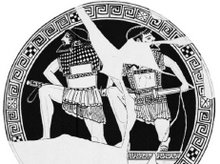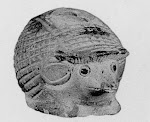When Push Comes to Shove: What Was the "Othismos" of Hoplite Combat?
Historia: Zeitschrift für Alte Geschichte
Bd. 58, H. 4 (2009), pp. 395-415
Published by: Franz Steiner Verlag
Article Stable URL: http://www.jstor.org/stable/25598486
Bd. 58, H. 4 (2009), pp. 395-415
Published by: Franz Steiner Verlag
Article Stable URL: http://www.jstor.org/stable/25598486
10.2307/25598486
And later in the book Storm of Spears:
There are serious flaws with his analysis and even more with his presentation. He contacted me early on in his studies, and in the interest of full disclosure I must tell that myself and few others attempted to steer him away from the mistaken path he was on.
I have been largely away from Ancient Greek topics for over a year now due to other demands on my time, but now that I have come back I am finding far too many online discussions where his portrayal of hoplite combat has taken root. I am loathe to enter into what must be a deconstruction of his thesis because he is a dedicated reenactor of ancient hoplites. For years I have been suggesting that he is exactly the type of researcher that those writing histories of Greek combat must heed. Reenactment can be, when done well, experimental archaeology. When it is it must conform to the ethics of a scientific experiment and honestly assess alternate views. In this Mathew's work fails. I assume these are honest mistakes, scientists make them all the time, but the bias he brings to his analysis is all too glaring in his presentation.
When his book came out, the general consensus I received from the many hoplite reenactors I correspond with was that the analysis in Storm of Spears was flawed based on their experience and his notions failed to convince the hoplites at the Marathon gathering. I had hoped that by now members of these other groups would have shot down the mistaken ideas, but I see now that perhaps they do not have the reach to disseminate their ideas as efficiently as Mathew does. I am not sure that I do either, but I will give it a try.
Before I step into the debate, here is an assessment of Mathew's use of percentages of vase depictions as evidence for the exclusive use of an Underhand grip for the hoplite spear. The author is my friend Fred Ray, who has written some really interesting books on hoplite battle. If you are reading this blog, then you should give them a look:
http://www.amazon.com/Land-Battles-5th-Century-Greece/dp/0786467738/ref=sr_1_1?ie=UTF8&qid=1412604879&sr=8-1&keywords=Land+Battles+in+5th+Century+B.C.+Greece
http://www.amazon.com/Greek-Macedonian-Land-Battles-Century/dp/0786469730/ref=sr_1_2?ie=UTF8&qid=1412604879&sr=8-2&keywords=Land+Battles+in+5th+Century+B.C.+Greece
I will note that I have no financial tie to these books, but I did give some advice on certain topics.
Here is Fred's review that her was kind enough to share with us on Hollow Lakedaimon:
Storm of Spears (2012, Pen & Sword Military) by C. Matthew:
Some Observations Regarding the Analysis of Artistic Images
Matthew’s analysis of
artistic portrayals in support of his core theory that hoplites within
classical phalanxes did not normally engage in shock combat using over-arm
strikes with their primary weapon (the thrusting spear) appears to be
fundamentally flawed. One can readily accept his contention (p. 20) that
a majority of the figures evaluated (an estimated 243 [71%] out of a sample of
340 in which the grip could be determined) show a weapon with a centrally
located point of balance. One can also easily buy the assertion (p.
21-23) that these devices are much more suitable for throwing than the sort of
thrusting spears designed for shock combat that were common to classical
phalanx battle. These latter favored a rearward grip (p. 8-11).
Such ideas find further backing from the information cited on length in
which the data sub-set of weapons held overhead (and dominated by central
grips) has a notably shorter average (p. 23-24). This is consistent with
devices that can be thrown effectively and contrasts with longer averages for
sub-sets dominated by weapons having rearward grips and therefore better suited
to thrusting (p. 14). The observation offered that sauroters best
associated with simple thrusting spears (p. 4-5) are more common on images of
longer/rear-grip weapons (p. 22) also backs this argument. Matthew’s
proposal (p. 31-33) that a majority of the images in the artistic record
portray archaic or mythological figures using weapons other than single-purpose
thrusting spears thus appears sound. However, while this bodes well for
his contentions (p. 23, 38) that past evaluations treating these weapons solely
as thrusting spears are likely in error, it does not lend support to his linked
assertion (p. 38) that essentially all fighting with the thrusting spear
used under-arm methods. Indeed, the image data presented actually appear
to disprove that particular concept.
Accepting that an apparent 243 (86% of the 60% fraction held over-arm plus half
of the 40% fraction held under-arm [p. 16]) among useable images involve
center-grip weapons other than those traditionally employed in classical era
shock action, only analysis of the remaining 97 figures (those with rearward
grips indicative of a single-purpose thrusting spear) are relevant to the
frequency of hand-to-hand techniques used by classical Greek spearmen. Of
these, 29 (30%) display an over-arm grip while 68 (70%) show an under-arm
grip. Given that an over-arm grip would have no real value outside of its
possible employment in shock combat, every image showing that approach with a
simple thrusting spear (unsuitable as a missile) must therefore have been meant
to portray a man engaging in (or preparing to engage in) shock fighting.
But figures displaying an under-arm grip could well be doing something else -
advancing while putting minimal stress on the spear-arm or resting that arm
during a lull in battle for example. This meshes with Matthew’s
simulation data (p. 122-125) that shows an under-arm pose to be less tiring
during combat. Also agreeing, if we discount the possibility (though it
is strong in my opinion) that the antique, center-grip weapons might be
dual-purpose spears useful for shock combat and are instead solely missile
weapons, is that those 68 figures holding center-grip weapons under-arm (28% of
the center-grip total) must be resting their throwing-arm in a similar
fashion. This means that we can count only those figures with an
under-arm grip that are also shown in the very midst of a shock fight as
truly secure examples of under-arm thrusting. Unfortunately, we are given
no value for this (or a table of rawer information from which it might be
derived).
As a result, given only
the image data provided by Matthew, one must conclude that an over-arm
technique for shock combat appears at least 30% of the time (that value being
the case should all of the images with under-arm grips describe ongoing
shock actions). And this could rise to as high as 100% (in the highly
unlikely case that none of the under-arm images show ongoing shock
actions). Therefore, with a technically possible 30-100% range for its
portrayal, the over-arm method for spear-fighting appears to find rather
convincing support within the artistic record as presented by Matthews, instead
of being completely ruled out as he asserts.
If we reject for
argument’s sake that some (or all) of the center-grip weapons in the images are
multi-purpose spears and assume them to all be missile weapons (“javelins” per
Matthew’s terminology), then we might use them as an analog for a more
refined guess at the likely percentage of over-head thrusting on display.
There are 243 images with mid-shaft grips and 68 (28%) of them are under-arm
poses not suitable for missile combat (where one could not throw the weapon in
hand). This suggests that only 175 (72%) of these images truly represent
men actively engaging at the instant shown. If the same ratio is applied
to figures with thrusting spears (rear-grip weapons), we can calculate that 41
among those shown in under-arm poses are also engaging in shock action.
(This adds that under-arm fraction to the 29 in over-arm stances suitable
for nothing but shock combat to reproduce the 72% share of combat stances in
the center-grip analog.) This would mean that there are 29 figures (40%
of the rear-grip total) making over-arm strikes and 41 (60%) striking under-arm
(interestingly, a mere inversion of the 60/40 ratio in favor of over-arm use
cited by some in considering that all images were showing shock combat
poses). Of course, before taking this kind of estimate “to the bank,” one
must again remember that it excludes all consideration of dual-purpose spears
being on display. Also, it must be viewed in the context that of the 480
figures initially studied by Matthew, only 340 (71%) provided useful
data. These were then reduced to 97 (20%) potentially relevant to the
specific question under review and only 70 (just 15% of the original total)
could then be applied to the investigation’s bottom line when all was said and
done. As such, even rather modest biasing of the sample pool by the
forces of chance in rendering 140 (a full 29%) of the original 480 figures
useless (precisely twice the number available for the final calculation) could
well have had quite a significant impact on the conclusions reached.)
We should further consider that even the foregoing rather more “over-arm
friendly” view of the artistic record might underestimate the frequency of that
method’s true employment. This is because very few (if any) of the
studied images are likely to be portraying the “othismos” stage of phalanx
combat in the “literal” (i.e. physical) sense. Here, hoplites would have
been pressed “belly-to-back” in a manner unsuited for the side-on views
commonly employed in ancient artworks. And an over-arm utilization of the
thrusting spear might well be the most practical method during othismos.
There is wide acceptance that such literal othismos is explicitly referenced in
several of our most detailed descriptions of phalanx battles (per Matthew’s
note on p. 237). And though Matthew considers it rare on the basis of
these being few in number, it remains likely (in my opinion) that similar
episodes of literal othismos developed in a much higher count of more poorly
documented actions featuring similar tactical dynamics.
- Fred
Ray



